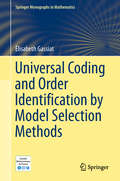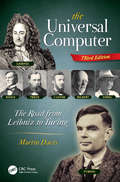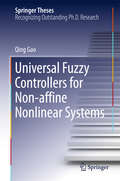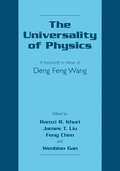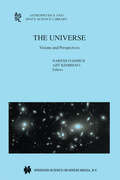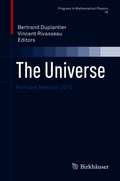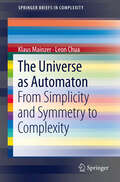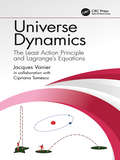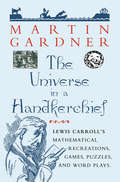- Table View
- List View
Universal Algebra and Lattice Theory: Proceedings of the Fourth International Conference Held at Puebla, Mexico, 1982 (Lecture Notes in Mathematics #1004)
by R. S. Freese O. C. GarciaUniversal Algebra for Computer Scientists (Monographs in Theoretical Computer Science. An EATCS Series #25)
by Wolfgang WechlerA new model-theoretic approach to universal algebra is offered in this book. Written for computer scientists, it presents a systematic development of the methods and results of universal algebra that are useful in a variety of applications in computer science. The notation is simple and the concepts are clearly presented. The book concerns the algebraic characterization of axiomatic classes of algebras (equational, implicational, and universal Horn classes) by closure operators generalizing the famous Birkhoff Variety Theorem, and the algebraic characterization of the related theories. The book also presents a thorough study of term rewriting systems. Besides basic notions, the Knuth-Bendix completion procedure and termination proof methods are considered. A third main topic is that of fixpoint techniques and complete ordered algebras. Algebraic specifications of abstract data types and algebraic semantics of recursive program schemes are treated as applications. The book is self-contained and suitable both as a textbook for graduate courses and as a reference for researchers.
Universal Algebraic Logic: Dedicated to the Unity of Science (Studies in Universal Logic)
by Hajnal Andréka Zalán Gyenis István Németi Ildikó SainThis book gives a comprehensive introduction to Universal Algebraic Logic. The three main themes are (i) universal logic and the question of what logic is, (ii) duality theories between the world of logics and the world of algebra, and (iii) Tarskian algebraic logic proper including algebras of relations of various ranks, cylindric algebras, relation algebras, polyadic algebras and other kinds of algebras of logic. One of the strengths of our approach is that it is directly applicable to a wide range of logics including not only propositional logics but also e.g. classical first order logic and other quantifier logics. Following the Tarskian tradition, besides the connections between logic and algebra, related logical connections with geometry and eventually spacetime geometry leading up to relativity are also part of the perspective of the book. Besides Tarskian algebraizations of logics, category theoretical perspectives are also touched upon. This book, apart from being a monograph containing state of the art results in algebraic logic, can be used as the basis for a number of different courses intended for both novices and more experienced students of logic, mathematics, or philosophy. For instance, the first two chapters can be used in their own right as a crash course in Universal Algebra.
Universal Artificial Intelligence: Sequential Decisions Based on Algorithmic Probability (Texts in Theoretical Computer Science. An EATCS Series)
by Marcus HutterPersonal motivation. The dream of creating artificial devices that reach or outperform human inteUigence is an old one. It is also one of the dreams of my youth, which have never left me. What makes this challenge so interesting? A solution would have enormous implications on our society, and there are reasons to believe that the AI problem can be solved in my expected lifetime. So, it's worth sticking to it for a lifetime, even if it takes 30 years or so to reap the benefits. The AI problem. The science of artificial intelligence (AI) may be defined as the construction of intelligent systems and their analysis. A natural definition of a system is anything that has an input and an output stream. Intelligence is more complicated. It can have many faces like creativity, solving prob lems, pattern recognition, classification, learning, induction, deduction, build ing analogies, optimization, surviving in an environment, language processing, and knowledge. A formal definition incorporating every aspect of intelligence, however, seems difficult. Most, if not all known facets of intelligence can be formulated as goal driven or, more precisely, as maximizing some utility func tion. It is, therefore, sufficient to study goal-driven AI; e. g. the (biological) goal of animals and humans is to survive and spread. The goal of AI systems should be to be useful to humans.
Universal Coding and Order Identification by Model Selection Methods (Springer Monographs in Mathematics)
by Élisabeth Gassiat Anna Ben-HamouThe purpose of these notes is to highlight the far-reaching connections between Information Theory and Statistics. Universal coding and adaptive compression are indeed closely related to statistical inference concerning processes and using maximum likelihood or Bayesian methods. The book is divided into four chapters, the first of which introduces readers to lossless coding, provides an intrinsic lower bound on the codeword length in terms of Shannon’s entropy, and presents some coding methods that can achieve this lower bound, provided the source distribution is known. In turn, Chapter 2 addresses universal coding on finite alphabets, and seeks to find coding procedures that can achieve the optimal compression rate, regardless of the source distribution. It also quantifies the speed of convergence of the compression rate to the source entropy rate. These powerful results do not extend to infinite alphabets. In Chapter 3, it is shown that there are no universal codes over the class of stationary ergodic sources over a countable alphabet. This negative result prompts at least two different approaches: the introduction of smaller sub-classes of sources known as envelope classes, over which adaptive coding may be feasible, and the redefinition of the performance criterion by focusing on compressing the message pattern. Finally, Chapter 4 deals with the question of order identification in statistics. This question belongs to the class of model selection problems and arises in various practical situations in which the goal is to identify an integer characterizing the model: the length of dependency for a Markov chain, number of hidden states for a hidden Markov chain, and number of populations for a population mixture. The coding ideas and techniques developed in previous chapters allow us to obtain new results in this area. This book is accessible to anyone with a graduate level in Mathematics, and will appeal to information theoreticians and mathematical statisticians alike. Except for Chapter 4, all proofs are detailed and all tools needed to understand the text are reviewed.
The Universal Coefficient Theorem and Quantum Field Theory: A Topological Guide for the Duality Seeker (Springer Theses)
by Andrei-Tudor PatrascuThis thesis describes a new connection between algebraic geometry, topology, number theory and quantum field theory. It offers a pedagogical introduction to algebraic topology, allowing readers to rapidly develop basic skills, and it also presents original ideas to inspire new research in the quest for dualities. Its ambitious goal is to construct a method based on the universal coefficient theorem for identifying new dualities connecting different domains of quantum field theory. This thesis opens a new area of research in the domain of non-perturbative physics—one in which the use of different coefficient structures in (co)homology may lead to previously unknown connections between different regimes of quantum field theories. The origin of dualities is an issue in fundamental physics that continues to puzzle the research community with unexpected results like the AdS/CFT duality or the ER-EPR conjecture. This thesis analyzes these observations from a novel and original point of view, mainly based on a fundamental connection between number theory and topology. Beyond its scientific qualities, it also offers a pedagogical introduction to advanced mathematics and its connection with physics. This makes it a valuable resource for students in mathematical physics and researchers wanting to gain insights into (co)homology theories with coefficients or the way in which Grothendieck's work may be connected with physics.
The Universal Computer: The Road from Leibniz to Turing, Third Edition
by Martin DavisThe breathtakingly rapid pace of change in computing makes it easy to overlook the pioneers who began it all. The Universal Computer: The Road from Leibniz to Turing explores the fascinating lives, ideas, and discoveries of seven remarkable mathematicians. It tells the stories of the unsung heroes of the computer age – the logicians.
The Universal Computer: The Road from Leibniz to Turing, Third Edition
by Martin DavisThe breathtakingly rapid pace of change in computing makes it easy to overlook the pioneers who began it all. The Universal Computer: The Road from Leibniz to Turing explores the fascinating lives, ideas, and discoveries of seven remarkable mathematicians. It tells the stories of the unsung heroes of the computer age – the logicians.
Universal Extensions and One Dimensional Crystalline Cohomology (Lecture Notes in Mathematics #370)
by B. Mazur W. Messinga
Universal Fuzzy Controllers for Non-affine Nonlinear Systems (Springer Theses)
by Qing GaoThis thesis provides a systematic and integral answer to an open problem concerning the universality of dynamic fuzzy controllers. It presents a number of novel ideas and approaches to various issues including universal function approximation, universal fuzzy models, universal fuzzy stabilization controllers, and universal fuzzy integral sliding mode controllers. The proposed control design criteria can be conveniently verified using the MATLAB toolbox. Moreover, the thesis provides a new, easy-to-use form of fuzzy variable structure control. Emphasis is given to the point that, in the context of deterministic/stochastic systems in general, the authors are in fact discussing non-affine nonlinear systems using a class of generalized T-S fuzzy models, which offer considerable potential in a wide range of applications.
Universal Logic, Ethics, and Truth: Essays in Honor of John Corcoran (1937-2021) (Studies in Universal Logic)
by Jean-Yves Béziau Timothy J. MadiganJohn Corcoran was a very well-known logician who worked on several areas of logic. He produced decisive works giving a better understanding of two major figures in the history of logic, Aristotle and Boole. Corcoran had a close association with Alfred Tarski, a prominent 20th-century logician. This collaboration manifested in Corcoran's substantial introduction to Tarski's seminal book, Logic, Semantics, Metamathematics (1956). Additionally, Corcoran's posthumous editorial involvement in 'What are logical notions?' (1986) breathed new life into this seminal paper authored by Tarski. His scholarly pursuits extended to the intricate explication of fundamental concepts in modern logic, including variables, propositions, truth, consequences, and categoricity. Corcoran's academic curiosity extended further to the intersection of ethics and logic, reflecting his contemplation of their interrelation. Beyond these theoretical contributions, Corcoran was deeply engaged in the pedagogical dimensions of logic instruction. This volume serves as a compilation of articles contributed by Corcoran's students, colleagues, and international peers. By encompassing a diverse range of subjects, this collection aptly mirrors Corcoran's wide-ranging interests, offering insights that not only deepen our understanding of his work but also advance the theoretical frameworks he explored.
Universal Routing Strategies for Interconnection Networks (Lecture Notes in Computer Science #1390)
by Christian ScheidelerThis book presents the history and state of the art of universal routing strategies, which can be applied to networks independently of their respective topologies. It opens with a self-contained introduction, accessible also to newcomers. The main original results are new universal network protocols for store-and-forward and wormhole routing with small buffers or without buffers; these results are presented in detail and their potential applications are discussed. The book ends with a summary of open problems and an outlook of future directions in the area of routing theory.
Universalities in Condensed Matter: Proceedings of the Workshop, Les Houches, France, March 15–25,1988 (Springer Proceedings in Physics #32)
by Remi Jullien Luca Peliti Rammal Rammal Nino BoccaraUniversality in Statistical Physics and Synergetics: A Comprehensive Approach to Modern Theoretical Physics
by Volker A. WeberrußThe Universality of Physics: A Festschrift in Honor of Deng Feng Wang
by Ramzi R. Khuri James T. Liu Feng Feng Chen Wenbiao Wenbiao GanDeng Feng Wang was born February 8, 1965 in Chongqing City, China and died August 15, 1999 while swimming with friends in the Atlantic Ocean off Island Beach State Park, New Jersey. In his brief life, he was to have an influence far beyond his years. On August 12th 2000, The Deng Feng Wang Memorial Conference was held at his alma mater, Princeton University, during which Deng Feng's mentors, collaborators and friends presented scientific talks in a testimonial to his tremendous influence on their work and careers. The first part of this volume contains proceedings contributions from the conference, with plenary talks by Nobel Laureate Professor Phil Anderson of Princeton University and leading Condensed Matter Theorists Professor Piers Coleman of Rutgers University and Professor Christian Gruber of the University of Lausanne. Other talks, given by collaborators, friends and classmates testify to the great breadth of Deng Feng Wang's influence, with remarkable connections shown between seemingly unrelated areas in physics such as Condensed Matter Physics, Superconductivity, One-Dimensional Models, Statistical Physics, Mathematical Physics, Quantum Field Theory, High Energy Theory, Nuclear Magnetic Resonance, Supersymmetry, M-Theory and String Theory, in addition to such varied fields outside of physics such as Oil Drilling, Mixed Signal Circuits and Neurology. The second part of the volume consists of reprints of some of Deng Feng Wang's most important papers in the areas of Condensed Matter Physics, Statistical Physics, Magnetism, Mathematical Physics and Mathematical Finance. This volume represents a fascinating synthesis of a wide variety of topics, and ultimately points to the universality of physics and of science as a whole. As such, it represents a fitting tribute to a remarkable individual, whose tragic death will never erase his enduring influence.
The Universe: Visions and Perspectives (Astrophysics and Space Science Library #244)
by Naresh Dadhich Ajit KembhaviIt is with great joy that we present a collection of essays written in honour of Jayant Vishnu Narlikar, who completed 60 years of age on July 19, 1998, by his friends and colleagues, including several of his for mer students. Jayant has had a long research career in astrophysics and cosmology, which he began at Cambridge in 1960, as a student of Sir Fred Hoyle. He started his work with a big bang, expounding on the steady state theory of the Universe and creating a new theory of gravity inspired by Mach's principle. He also worked on action-at-a-distance electrodynamics, inspired by the explorations of Wheeler, Feynman and Hogarth in that direction. This body of work established Jayant's rep utation as a bold and imaginative physicist who was ever willing to take a fresh look at fundamental issues, undeterred by conventional wis dom. This trait, undoubtedly inherited from his teacher and mentor, has always remained with Jayant. It is now most evident in his untir ing efforts to understand anomalies in quasar astronomy, and to develop the quasi-steady state cosmology, along with a group of highly distin guished astronomers including Halton Arp, Geoffrey Burbidge and Fred Hoyle. In spite of all this iconoclastic activity, Jayant remains a part of the mainstream; he appreciates as well as encourages good work along conventional lines by his students and colleagues. This is clear from the range of essays included in this volume, and the variety and distribution of the essayists.
The Universe: Poincaré Seminar 2015 (Progress in Mathematical Physics #76)
This volume provides a detailed description of some of the most active areas in astrophysics from the largest scales probed by the Planck satellite to massive black holes that lie at the heart of galaxies and up to the much awaited but stunning discovery of thousands of exoplanets. It contains the following chapters: • Jean-Philippe UZAN, The Big-Bang Theory: Construction, Evolution and Status • Jean-Loup PUGET, The Planck Mission and the Cosmic Microwave Background • Reinhard GENZEL, Massive Black Holes: Evidence, Demographics and Cosmic Evolution • Arnaud CASSAN, New Worlds Ahead: The Discovery of ExoplanetsReinhard Genzel and Andrea Ghez shared the 2020 Nobel Prize in Physics “for the discovery of a supermassive compact object at the centre of our galaxy’”, alongside Roger Penrose “for the discovery that black hole formation is a robust prediction of the general theory of relativity”. The book corresponds to the twentieth Poincaré Seminar, held on November 21, 2015, at Institut Henri Poincaré in Paris. Originally written as lectures to a broad scientific audience, these four chapters are of high value and will be of general interest to astrophysicists, physicists, mathematicians and historians.
The Universe as Automaton: From Simplicity and Symmetry to Complexity (SpringerBriefs in Complexity #1)
by Klaus Mainzer Leon ChuaThis Brief is an essay at the interface of philosophy and complexity research, trying to inspire the reader with new ideas and new conceptual developments of cellular automata. Going beyond the numerical experiments of Steven Wolfram, it is argued that cellular automata must be considered complex dynamical systems in their own right, requiring appropriate analytical models in order to find precise answers and predictions in the universe of cellular automata.Indeed, eventually we have to ask whether cellular automata can be considered models of the real world and, conversely, whether there are limits to our modern approach of attributing the world, and the universe for that matter, essentially a digital reality.
Universe Dynamics: The Least Action Principle and Lagrange’s Equations
by Jacques Vanier Cipriana Tomescu (Mandache)Brought together in one focused and exclusive treatment, this book provides an elementary introduction to the important role and use of the least action principle and the resulting Lagrange’s equations in the analysis of the laws that govern the universe. It is an ideal complimentary resource to accompany undergraduate courses and textbooks on classical mechanics. Features: Uses mathematics accessible to beginners Brings together the Principle of Least Action, Lagrange's equations, and variational principles in mechanics in one cohesive text Written in a clear and easy-to-understand manner
The Universe in a Handkerchief: Lewis Carroll’s Mathematical Recreations, Games, Puzzles, and Word Plays
by Martin GardnerThis book contains scores of intriguing puzzles and paradoxes from Lewis Carroll, the author of Alice in Wonderland, whose interests ranged from inventing new games like Arithmetical Croquet to important problems in symbolic logic and propositional calculus. Written by Carroll expert and well-known mathematics author Martin Gardner, this tour through Carroll's inventions is both fun and informative.
The Universe in Zero Words: The Story of Mathematics as Told through Equations
by Dana MackenzieMost popular books about science, and even about mathematics, tiptoe around equations as if they were something to be hidden from the reader's tender eyes. Dana Mackenzie starts from the opposite premise: He celebrates equations. No history of art would be complete without pictures. Why, then, should a history of mathematics--the universal language of science--keep the masterpieces of the subject hidden behind a veil? The Universe in Zero Words tells the history of twenty-four great and beautiful equations that have shaped mathematics, science, and society--from the elementary (1+1=2) to the sophisticated (the Black-Scholes formula for financial derivatives), and from the famous (E=mc2) to the arcane (Hamilton's quaternion equations). Mackenzie, who has been called "a popular-science ace" by Booklist magazine, lucidly explains what each equation means, who discovered it (and how), and how it has affected our lives. Illustrated in color throughout, the book tells the human and often-surprising stories behind the invention or discovery of the equations, from how a bad cigar changed the course of quantum mechanics to why whales (if they could communicate with us) would teach us a totally different concept of geometry. At the same time, the book shows why these equations have something timeless to say about the universe, and how they do it with an economy (zero words) that no other form of human expression can match. The Universe in Zero Words is the ultimate introduction and guide to equations that have changed the world.
The Universe in Zero Words: The Story of Mathematics as Told through Equations
by Dana MackenzieMost popular books about science, and even about mathematics, tiptoe around equations as if they were something to be hidden from the reader's tender eyes. Dana Mackenzie starts from the opposite premise: He celebrates equations. No history of art would be complete without pictures. Why, then, should a history of mathematics--the universal language of science--keep the masterpieces of the subject hidden behind a veil? The Universe in Zero Words tells the history of twenty-four great and beautiful equations that have shaped mathematics, science, and society--from the elementary (1+1=2) to the sophisticated (the Black-Scholes formula for financial derivatives), and from the famous (E=mc2) to the arcane (Hamilton's quaternion equations). Mackenzie, who has been called "a popular-science ace" by Booklist magazine, lucidly explains what each equation means, who discovered it (and how), and how it has affected our lives. Illustrated in color throughout, the book tells the human and often-surprising stories behind the invention or discovery of the equations, from how a bad cigar changed the course of quantum mechanics to why whales (if they could communicate with us) would teach us a totally different concept of geometry. At the same time, the book shows why these equations have something timeless to say about the universe, and how they do it with an economy (zero words) that no other form of human expression can match. The Universe in Zero Words is the ultimate introduction and guide to equations that have changed the world.
The Universe of Conics: From the ancient Greeks to 21st century developments
by Georg Glaeser Hellmuth Stachel Boris OdehnalThis text presents the classical theory of conics in a modern form. It includes many novel results that are not easily accessible elsewhere. The approach combines synthetic and analytic methods to derive projective, affine and metrical properties, covering both Euclidean and non-Euclidean geometries.With more than two thousand years of history, conic sections play a fundamental role in numerous fields of mathematics and physics, with applications to mechanical engineering, architecture, astronomy, design and computer graphics.This text will be invaluable to undergraduate mathematics students, those in adjacent fields of study, and anyone with an interest in classical geometry.Augmented with more than three hundred fifty figures and photographs, this innovative text will enhance your understanding of projective geometry, linear algebra, mechanics, and differential geometry, with careful exposition and many illustrative exercises.
The Universe of Quadrics
by Boris Odehnal Hellmuth Stachel Georg GlaeserThe Universe of QuadricsThis text presents the theory of quadrics in a modern form. It builds on the previously published book "The Universe of Conics", including many novel results that are not easily accessible elsewhere. As in the conics book, the approach combines synthetic and analytic methods to derive projective, affine, and metrical properties, covering both Euclidean and non-Euclidean geometries.While the history of conics is more than two thousand years old, the theory of quadrics began to develop approximately three hundred years ago. Quadrics play a fundamental role in numerous fields of mathematics and physics, their applications ranging from mechanical engineering, architecture, astronomy, and design to computer graphics.This text will be invaluable to undergraduate and graduate mathematics students, those in adjacent fields of study, and anyone with a deeper interest in geometry. Complemented with about three hundred fifty figures and photographs, this innovative text will enhance your understanding of projective geometry, linear algebra, mechanics, and differential geometry, with careful exposition and many illustrative exercises.
The Universe Speaks in Numbers: How Modern Maths Reveals Nature's Deepest Secrets
by Graham Farmelo'A superbly written, riveting book.' Martin ReesSearching for the fundamental laws of the universe, physicists have found themselves developing ambitious mathematical ideas. But without observation and experiment as their guide, are they now doing 'fairy-tale physics' as their detractors claim?In The Universe Speaks in Numbers, Graham Farmelo argues that today's greatest scientific minds are working in a tradition that dates back to Newton. He takes us on an adventure, from the Enlightenment to the breakthroughs of Einstein and Dirac, to the work of modern physicists and mathematicians shedding light on each other's disciplines, to their mutual surprise and excitement. This blossoming relationship is responsible for huge advances in our understanding of space and time - and as Farmelo explains, could redefine reality as we know it.




